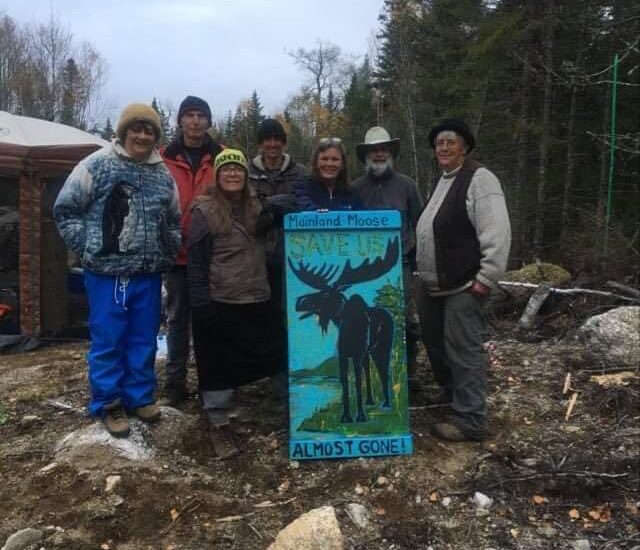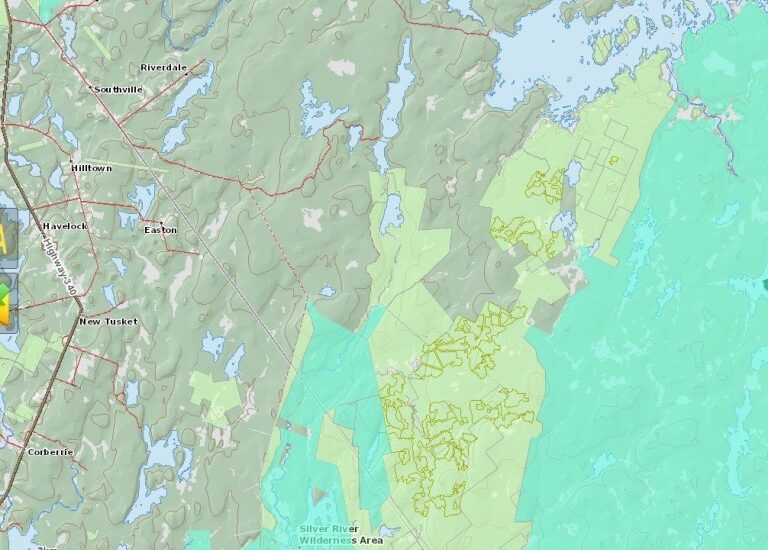
KJIPUKTUK (Halifax) – The occupation of forest land on behalf of the mainland moose in Digby County by members of Extinction Rebellion and others continues.
According to Facebook posts the people involved, experienced campers all, remain in good spirits despite chilly and damp weather, and forestry workers have not yet entered the scene.
The land in question, positioned between the Tobeatic and Silver River Wilderness Area, is relatively unfragmented by roads and provides shelter and nurture to mainland moose, a threatened species in steep decline.
“Once new roads are built the impact on the area lasts for many years to come. Doing so facilitates the infiltration of white-tailed deer, poachers, and recreation-based impacts where they were previously absent, or minimal,” writes Mike Lancaster, one of the admins of the excellent Healthy Forest Coalition (HFC) facebook page.
In the same post Lancaster calls for a deferral of any further road construction until a review occurs, and an assessment of Protected Areas potential for connectivity issues and the expansion of Silver River Wilderness Area.
Lancaster, speaking on behalf of the HFC, also calls for the transferral of responsibility for wildlife and Species at Risk aways from Lands and Forestry. “Species like the mainland moose, teetering on the brink of expiration from Nova Scotia, cannot afford this ongoing loss of habitat,” he writes.
In the following interview we explore these issues a bit further.
Can you talk a bit about the lands in question, and why they need to be protected?
My main interest comes from a landscape connectivity and landscape ecology perspective. We are dealing with a connective region of public land between Silver Lake, or the Silver River Wilderness Area, and the Tobeatic Wilderness Area.

One of the main concerns for conservation in Nova Scotia is habitat connectivity and the threat presented by the fragmentation that’s occurring. There’s been some infiltration of roads coming from both the north and the south of the area, and it seems that the plan is for these roads to eventually connect.
Right now it’s one of the few areas in Nova Scotia that remains non-fragmented, and regardless of the presence of moose, it’s important to maintain these unfragmented corridors in Nova Scotia, to provide a habitat for the species at risk, moose being the example in this case. Clearcutting exacerbates everything even more.
When a clearcut happens within a couple of decades you’ll have a forest come back. Mind you, it might not be as healthy, but eventually you’ll get there, in 100 years or so. But with the construction of a road we’re not talking about 100 year recovery, we’re talking potentially several centuries of recovery to see such an area reclaimed by a healthy ecosystem.
You are also asking that these public lands are considered for further protection.
For the reasons I just explained we’re calling for an expansion of the Silver River Wilderness Area. We need to ensure that we’re more carefully planning how our protected areas are connected across Nova Scotia. This just seems like an area where it just makes total sense to have that connectivity.
Lands and Forestry minister Ian Rankin told the CBC that if there are moose in an area designated for cutting it would be considered in any approvals.
If there is deemed to be a moose concentration in an areaLands and Forestry will employ what are called special management practices. One of the ecosystem components that moose need for part of their lifecycle is open areas for ample amounts of browse.That means that large clear cuts like this are kind of justified under those special management practices.
But what that doesn’t take into account is that an absence of these large open areas with lots of browse is not a component that’s lacking. What is lacking however is old forest, especially coniferous- dominant old forest where moose can spend their winters and get sheltered from snow and get proper nutrition. Moose have more than enough browse that they can get in other areas, but they can’t get the shelter in an old coniferous-dominant forest, these are very few and far between in public forests.
I have a forestry background and I would rather see an application of sustainable light-touch forestry across the board. Forestry has a valuable place in Nova Scotia, especially in rural economies. But this is not it.
If you do things right, then you wouldn’t have these conflicts. What’s a little frustrating for me is that we don’t need to have all this constant butting of heads.
In the post you called for a transfer of responsibilities around wildlife and Species at Risk aways from Lands and Forestry. Why is that?
If you design a department to promote forestry values and to manage species at risk, then at some point those two responsibilities are going to come into conflict. The current issues around the Digby County lands is a case where such a conflict is very clearly illustrated.
Earlier this year we had the landmark court case that clearly called out the practices of the department as inadequate to uphold the law. As well several Auditor General reports identified this over the years. All this kind of begs the question, how many reports and decisions do we need to conclude that the current setup is not working?
I think the department needs some support, perhaps from the department of Environment. Lands and Forestry do have excellent wildlife biologists, but for the most part their department is centered around forestry values. For instance, they don’t have the necessary contingent of ecologists to provide this broader and different perspective. Something is not working, that much is clear.
Update: Lands and Forestry responds
Updated October 30, 2020: We received a response from the department of Lands and Forestry to questions we had submitted on Monday.
“The Department of Lands and Forestry considers important habitat for moose in all harvesting decisions, including those in Digby county. We have mapped moose concentration areas, and where forest harvesting is planned within these areas, additional forest is retained to provide areas for moose shelter. These Special Management Practices for moose have been in place for several years. More information about these, including areas of concentration and the type of shelter, can be found here,” writes Brian Taylor, spokesperson for the department.
“With the proper Special Management Practices listed at the link above are being followed, harvests can proceed, as appropriate measures to protect moose activity on the mainland are being closely monitored. The Special Management Practices ensure the required amount of habitat remains for moose to shelter and feed in the area,” the department’s email concludes.
See also: News brief: Mainland moose habitat in Digby County occupied to protect it from clearcutting
With a special thanks to our generous donors who make publication of the Nova Scotia Advocate possible.
Subscribe to the Nova Scotia Advocate weekly digest and never miss an article again. It’s free!



